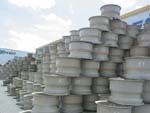
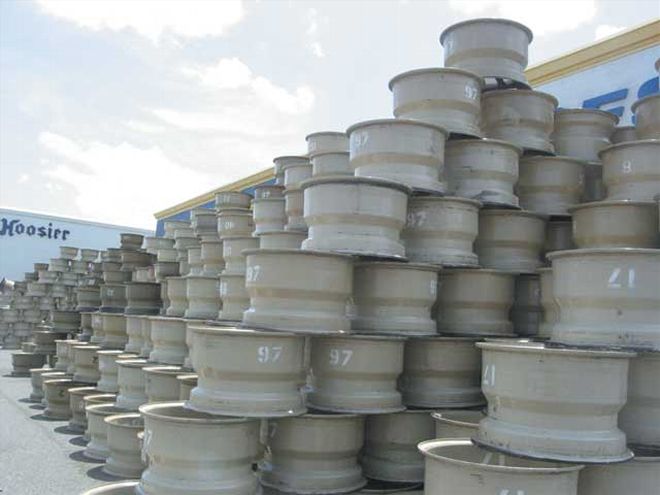 The NASCAR Nextel Cup Series teams use strong wheels. All designs mustadhere to strict requirements so that the whole racing environment,which includes the drivers, fans, officials, and crews, are less atrisk.
The NASCAR Nextel Cup Series teams use strong wheels. All designs mustadhere to strict requirements so that the whole racing environment,which includes the drivers, fans, officials, and crews, are less atrisk.
Like so many other parts on our race cars, the wheel has undergoneconsiderable development and improvement over the last 20 or so years.The wheel is under more stress than we might realize and it is the lastpiece of metal between our car's suspension and the racing surface.
The reason we needed to further develop the strength of the circle trackracing wheel is because of the forces that act on it and the way inwhich those forces concentrate on small areas of the wheel. Toillustrate the point, if we have a 2,800-pound car and a 50/50front-to-rear weight percentage distribution, we have 1,400 poundssupported by the two tires at each end of the car. During cornering, thetires resist the lateral forces by gripping the track surface, and eachtire transfers this force to the wheel. The wheel is the firstmechanical part on the car that resists the cornering forces. Here ishow the wheel accomplishes that task.
Defining the Wheel Forces
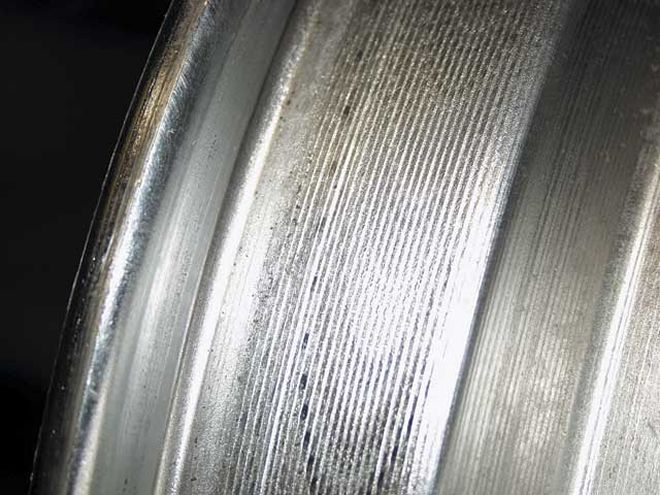 Here we can see the area of a spun wheel between the middle and the rim.This process promotes a lighter wheel while serving to produce areas ofincreased thickness where we need the strength. The spun process alsoinsures that the run-out is forced to be correct for a true form as faras roundness and conformity in material thickness.
Here we can see the area of a spun wheel between the middle and the rim.This process promotes a lighter wheel while serving to produce areas ofincreased thickness where we need the strength. The spun process alsoinsures that the run-out is forced to be correct for a true form as faras roundness and conformity in material thickness.
Even with the left side rules in place allowing a higher than 50 percentleft-side weight, the right-side tires end up supporting around 60percent of the race car's weight because of the weight transfer duringcornering. So, the right-front tire and wheel could end up with (1,400 x0.60 =) 840 pounds of vertical weight.
We can consider that the right-front tire will also resist approximately60 percent of the lateral forces acting at the front of the car. If theg-force at mid-turn was 1.5, a common average for most medium-bankedasphalt tracks and well within range for higher-banked dirt tracks withsome degree of grip, then the right-front tire/wheel combination is nowresisting 1,260 pounds of lateral force. That is a lot for our wheels toresist.
But, in reality, the 1,260 pounds is resisted by only around 6-8 inchesof rim on the inside (towards the inside of the track) of the wheel atany given moment in time. Why? Because the tire contact patch is thefirst part of the car to resist the lateral forces. The force is thentransmitted up to the rim, but only that part of the rim directly abovethe contact patch. The part of the rim at the top of the wheel resistsnothing. In this snapshot of time, there is very little force on therest of the rim on this wheel except that part directly above the tirecontact patch. The wheel is spinning, so all parts of the rim experiencethe force, but only 6-8 inches at a time.
Now imagine if we could mount the wheel horizontally and hang 1,260pounds off the edge of the rim that is attached to it by rollers thatare only 8 inches wide. Now, we spin the wheel with the weight rollersstaying stationary and acting on the entire length of the rim, 8 inchesat a time. If the wheel and rim portion are not strong enough, theconstant weight that is exerted on that small portion of the rim willdistort it and eventually reshape the bead area so that the tire couldeventually slip off the rim. On the racetrack, this would result in asudden loss of tire pressure and a quick trip to the wall.
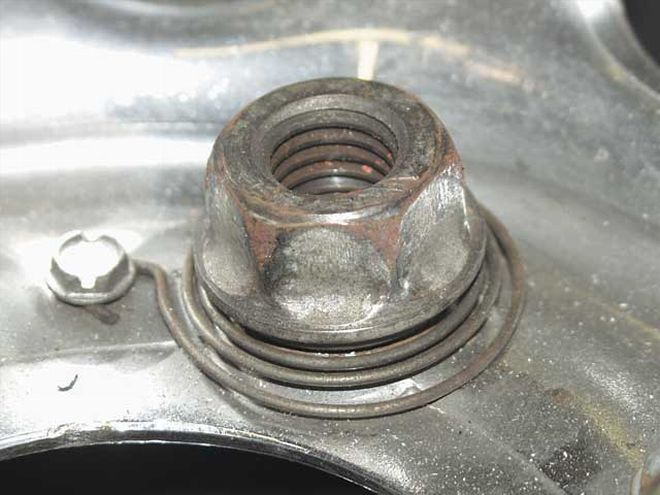 The center piece where the lug nut holes are located is visibly thickerthan other non-stressed areas of the wheel. Note that the slots abovethe lug nut in the photo are flanged to add further strength to thecenter section.
The center piece where the lug nut holes are located is visibly thickerthan other non-stressed areas of the wheel. Note that the slots abovethe lug nut in the photo are flanged to add further strength to thecenter section.
In addition to the load at the wheel rim, a torsional, offset load isalso exerted on the wheel center and that causes a good deal of flexthrough the center piece and into the shell of the wheel. This works toweaken the area where the center is welded to the shell.
Knowing this, we now see why wheel companies have worked very hard tomake their wheels stronger and lighter. While it might seem like the useof stronger and lighter to describe a design sounds like an oxymoron,there is a way to design a wheel so that it is truly stronger andlightweight. That is accomplished by knowing where strength is neededand where we can sacrifice some thickness of the metal withoutcompromising the integrity of the structure. Let's study the parts ofthe whole wheel so we can see where the strength is needed.
There are two main parts to a wheel, the center section and the shell.The shell, or outer portion, can be formed by either a rolled process orby a spun process. If a wheel shell is rolled, the starting piece ofmetal is a round tube and is placed inside of a shaped die. The tube isthen rolled and stretched to conform to the die. This process is fastand economical, but it is inherently hard to maintain a uniformthickness and a true run-out shape due to the way the dies are used andthe wear that can occur over a period of time. The rolled process isfine for trailer wheels and other non-racing applications, and we cansometimes get by using these lower cost wheels for circle track racing,but sources tell us that even though all racing wheels will fatigue andfail at some point in time, the wheels that are produced by the spunprocess might last as much as twice as long.
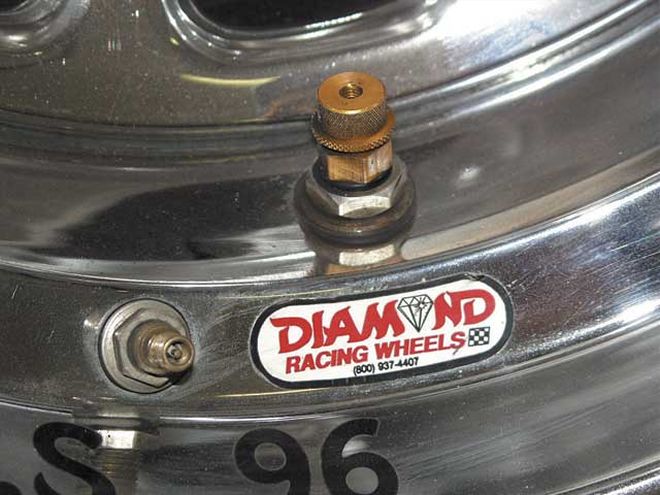 By using two valves, a bleeder and a standard tire valve, this team caninflate or deflate the gas in the tire without removing the bleedervalve. The bleeder is sensitive to handling and may not performaccurately if it is constantly removed and reinstalled.
By using two valves, a bleeder and a standard tire valve, this team caninflate or deflate the gas in the tire without removing the bleedervalve. The bleeder is sensitive to handling and may not performaccurately if it is constantly removed and reinstalled.
The spun process is done a little differently. The original tube ofmetal is larger than the die and placed outside of it. It is then spuninto the die and tightly against it. Since the die is machined perfectlyand the shell is forced to conform to that shape, the result is a muchbetter, almost perfect run-out with control of critical thicknesses inareas where we would see the most flexing and stress.
Spun wheels are more expensive due to the extra time in the process, theexpense of the CNC machinery, and the quality control that isincorporated.
In choosing our wheels, we can sacrifice a little weight and still havestrength by buying a heavier wheel at a lower cost if money is an issue.But if the budget allows, we should opt for the lighter, truer, andstronger spun wheel for all of the right reasons. In no event should weuse a light wheel that may not have sufficient strength to endure thelateral forces that may be encountered. Time will tell, because if yourwheel is not strong enough, it will eventually give up.
Center Section
The center section is stamped and then spun to create the shape that isneeded. The critical areas that need to be stronger (as in thickermetal) are where the wheel stud holes are located and where the edge ofthe center piece is welded to the shell. The metal between the studs andthe shell mostly spreads out the forces and can be of less thickness.
Modifications have been incorporated into the design of the centersection in order to accommodate the handling of the wheel, especially tohelp speed up the pit stops during a race. Reshaping the holes in thecenter section can help a crew member grab and hold onto the wheel as itis placed on the hub. Developing a deeper dish shape moves the holescloser to the outside of the rim so the tire handler does not have toreach as far into the shell to grab the holes in the center section aswell as providing for better brake rotor cooling. The back side of thecenter piece where the holes are located can also be cambered to allowthe studs to "find" the holes easier, and that lets the tire changerlocate the wheel on the studs quicker.
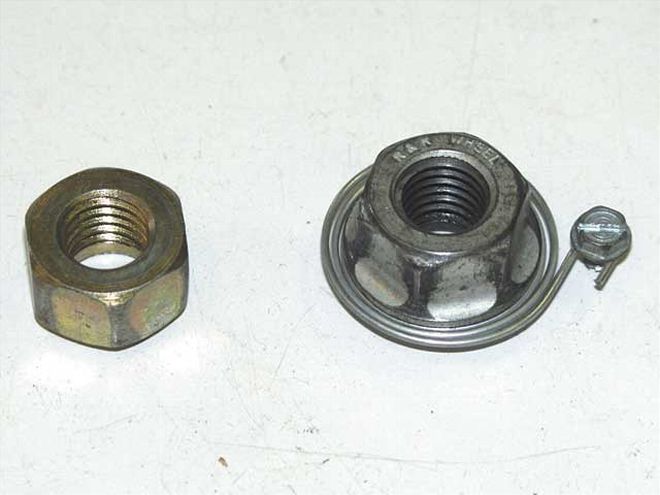 A standard lug nut is shown on the left next to a spring mounted lugnut. Note the flange on the back side of the spring nut. This helpslocate and center the socket more square to the nut reducing the chanceof the nut turning sideways and sticking in the socket.
A standard lug nut is shown on the left next to a spring mounted lugnut. Note the flange on the back side of the spring nut. This helpslocate and center the socket more square to the nut reducing the chanceof the nut turning sideways and sticking in the socket.
Another reason the wheel stud hole areas need to be made thicker forsome of the touring series teams is because they make pit stops duringevery race and those teams glue the lug nuts onto the wheel right beforethe race starts. After the race, the glue must be removed from theholes. Most teams use a metal wire wheel. Using this type of tool does agreat job of cleaning the wheel holes and removing paint and glue, butthe process also removes a small amount of metal. If the team uses thewire wheel long enough, that area of the wheel will become thinner andweaker. A small crack that originates here can grow all the way to theshell and cause a total failure of the wheel.
Shell Strength
The two areas of the shell that need added thickness for strength arethe rim area located next to the bead and the middle where the centerpiece is welded to the shell. As in the design of the center piece, thepart of the shell that lies between the rim and the middle where thecenter is welded can be thinner than other highly stressed areas. In thespun process, this area is shaped so that some of the metal is forcedinto areas of high stress for added strength and that is one of theadvantages of this process.
Again, we need to imagine where the forces are located and strengthenthose areas as a priority. Racing wheels must maintain strength at bothrims because the wheel might be used on either the left or the rightside of the car. Mostly the "inside" rim, meaning the rim closest to theinside of the racetrack, is loaded from the lateral forces that occurwhile cornering. It would be a good idea to inspect those areas fordeformities after each race. At least one racer has noted that thefailure of the rim was noticeable once they knew what to look for.
The most common failure for racing wheels is in the area of the center,either where the center section is welded to the shell, or where thewheel studs come through the wheel. That is why most higher qualitywheels add strength to both of those areas.
Back Spacing
Back spacing refers to the distance from the outside edge of the rim tothe back of the center piece where it meets the hub face. This spacingcontrols both the track width and the lateral location of the chassis.If we need more or less left side weight, we can use different offsetwheels on each side to accomplish those goals. We cannot widen the carbeyond the rule specifications, but we can take the track width to themaximum by using lower back spacing.
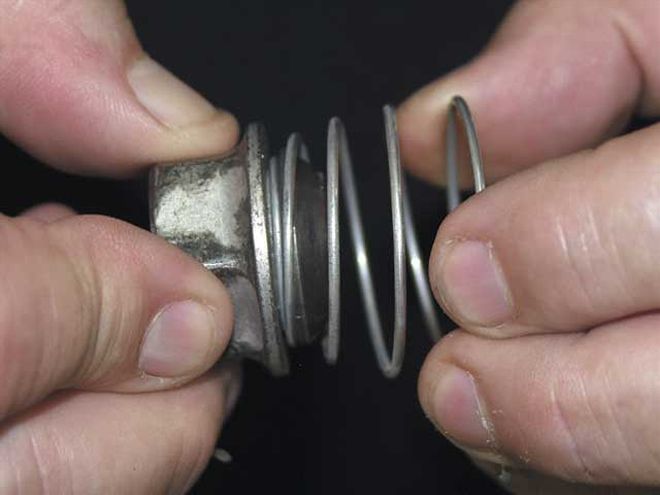 The spring keeps the lug nut centered and attached to the wheel so wedon't need to use a pliable glue. The spring attachment point allows thelug nut to turn inside the spring wire while zipping it on during aquick pit stop.
The spring keeps the lug nut centered and attached to the wheel so wedon't need to use a pliable glue. The spring attachment point allows thelug nut to turn inside the spring wire while zipping it on during aquick pit stop.
Another use of split back spacing would be to line up the driveshaftfrom a top view. A lot of attention is now being paid to reducinguniversal joint angles, from any view, and the rear end can be relocatedlaterally by the use of different offset wheels. This may necessitateusing odd offset wheels at each end of the car on each side, but ifperformance is enhanced, then it is worth the trouble it takes to keeptrack of the wheels.
High amounts of back spacing can result in increased brake rotor heatdue to the rotor being placed farther into the wheel shell and out ofthe flow of air that would normally help cool the brakes. This, in turn,serves to heat the wheel excessively and that heat is transferred to thegas inside the tire. As the gas heats up it expands, and the tire willgrow in pressure more than if the rotor was located farther outside thewheel.
Pressure Bleeders
Some tracks and sanctioning bodies allow the use of tire pressurebleeders. These units will hold a certain pressure, but pop off andbleed gas as the pressure rises above a pre-set level.
This allows the team to start out the race with pressures closer to theoptimum race pressure and still maintain that ideal level once the gasinside the tire expands due to the heat. If a team is not allowed to usebleeders, they must anticipate the rise in pressure and start out with amuch lower pressure so that as the heat and gas pressure grows, it willnot exceed the optimum pressure needed for producing a proper contactpatch footprint.
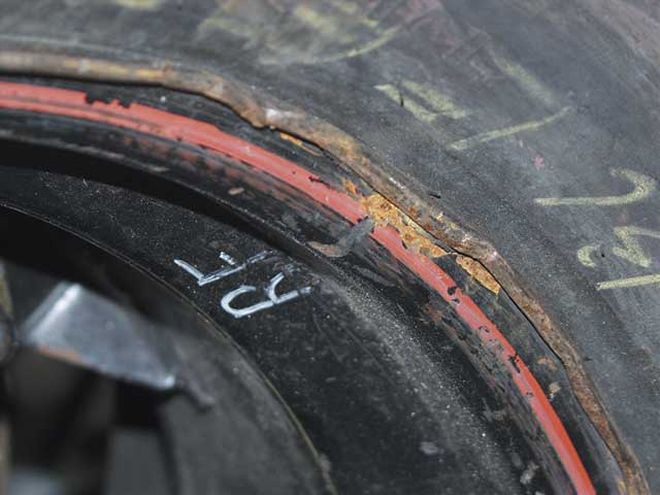 Do not let your wheel get to the point of being bent and battered.Sooner or later, the rim may break and the small cost savings youexperience from reusing worn wheels will translate into a high cost ofreplacing a front end or worse. There is a high degree of lateral loadthat the wheel must resist. Most wheels are less costly than a tire, andwe replace tires on a weekly basis most times.
Do not let your wheel get to the point of being bent and battered.Sooner or later, the rim may break and the small cost savings youexperience from reusing worn wheels will translate into a high cost ofreplacing a front end or worse. There is a high degree of lateral loadthat the wheel must resist. Most wheels are less costly than a tire, andwe replace tires on a weekly basis most times.
Some teams use two-valve stems when using a bleeder system so they canfill or deflate the tire with a standard stem while not disturbing thebleeder valve.
Lug Nuts
There are several types of lug nuts that can be used. The standard typeof racing lug nut is fine for everyday use on most short tracks. If pitstops are a must, a spring mounted lug nut is available that staysattached to the wheel and also has a flanged back side which makes italmost impossible to hang and get stuck in the lug socket.
There are specially designed racing lug nut sockets that have widerradii to help prevent the lug nut from getting stuck in the socket, acommon occurrence during fast pit stops. These are a necessity for anyteam, whether pit stops are normally required or not. We never know whenan unexpected problem will require a quick stop to replace a flat tire.
Final Thought
Maintain your wheels and inspect them often. Don't let a fatigued orbattered wheel cost you a race or possibly a front clip. It would be agood idea to rotate the wheels from side to side occasionally due to thefact that the stress is only being felt on opposite sides of the wheelfor left- and right-side wheel mounts. Replace your wheels after hardcontact with the wall whether they are bent or not. Small cracks mayhave developed that the eye cannot detect. After all, it's yourinvestment and especially your driver's health we are most concernedabout.